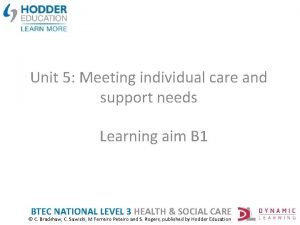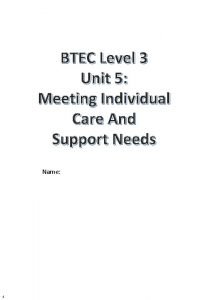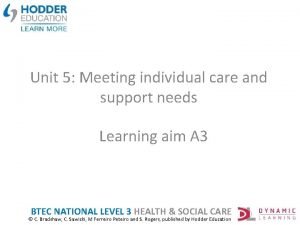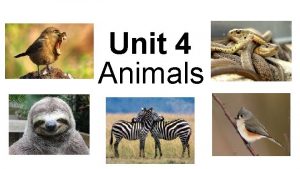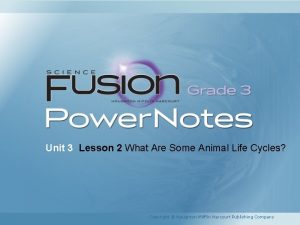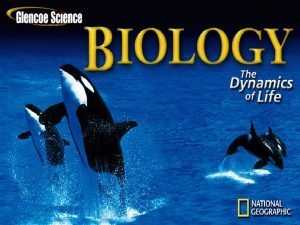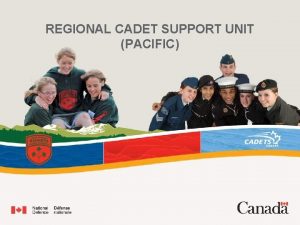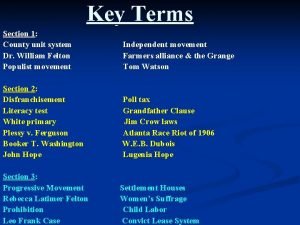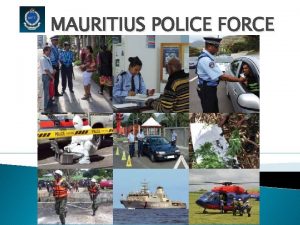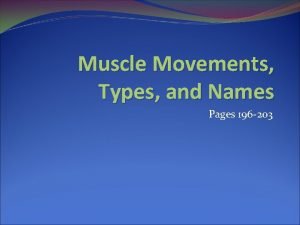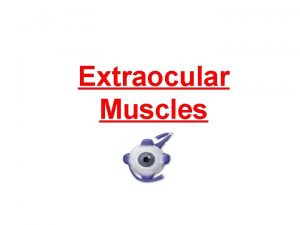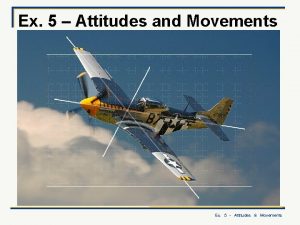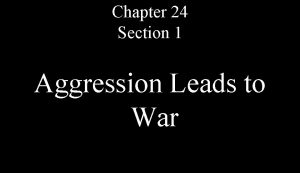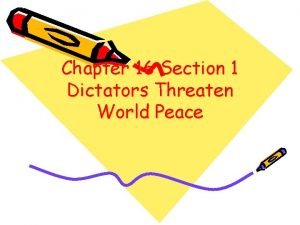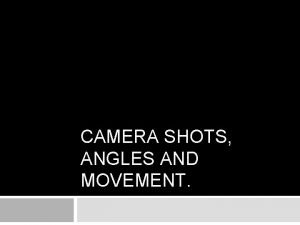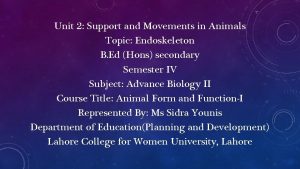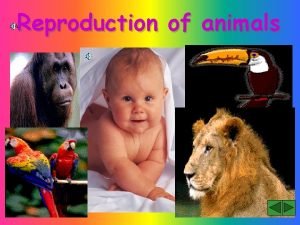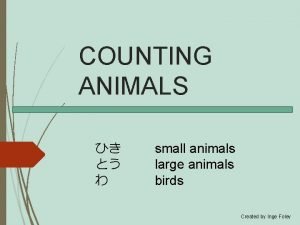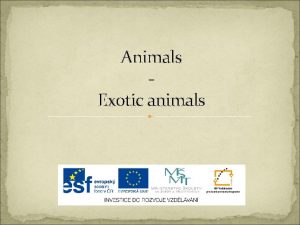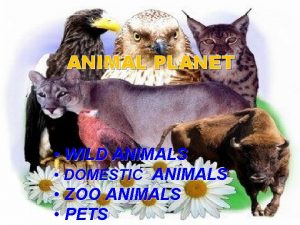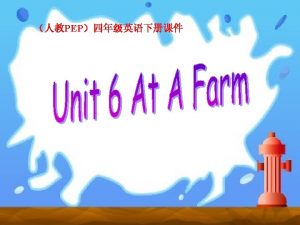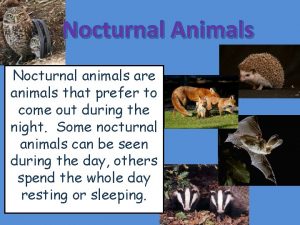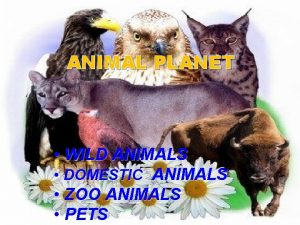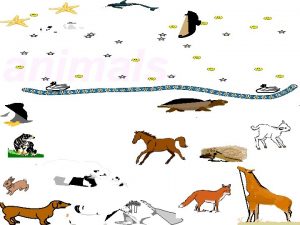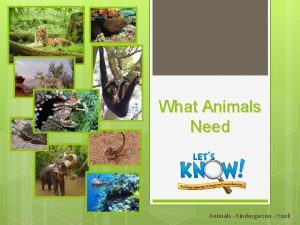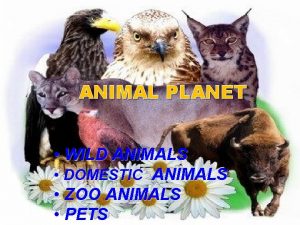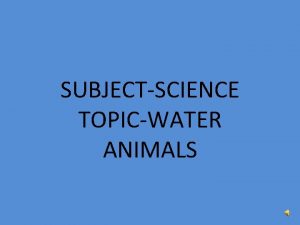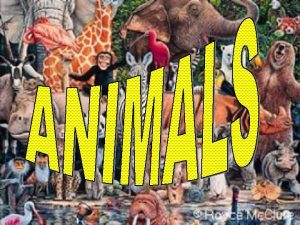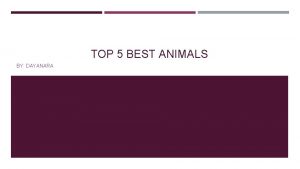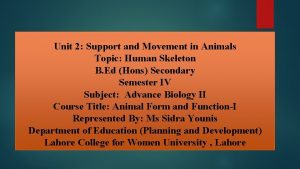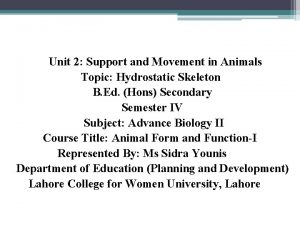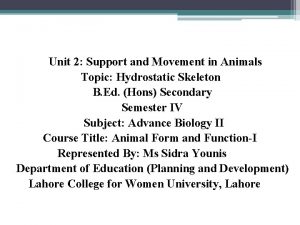Unit 2 Support and Movements in Animals Topic



























- Slides: 27

Unit 2: Support and Movements in Animals Topic: Endoskeleton B. Ed (Hons) secondary Semester IV Subject: Advance Biology II Course Title: Animal Form and Function-I Represented By: Ms Sidra Younis Department of Education(Planning and Development) Lahore College for Women University, Lahore

SKELETON • “The skeleton is the supporting structure of an organism” There are three different types of skeletons: Hydrostatic skeleton: Water exerts pressure on muscular walls, for example, in jellyfish. Exoskeleton: The stable chitinous or mineralized outer shell of an organism, for example, the shell of a grasshopper or prawn. Endoskeleton: A cartilaginous or mineralized support structure inside the body, for example, in humans and other vertebrates.


Evolutionary Development of Skeleton • The earliest forms of life evolved in the oceans. Water is about 1000 times denser than air. • Density of water also provides resistance to movement and animals had to adapt to ensure that they were able to move efficiently through water. • An early adaptation by organisms was the ability to change the hydrostatic pressure within different chambers of their bodies to enable quick movement. This resulted in the development of hydrostatic skeletons. Animals with this type of skeleton include jellyfish, octopus and sea anemones.

• Over time, in order to refine movement and improve protection from predators, some organisms developed a hard chitinous exoskeleton. • Exoskeletons first developed in the aquatic environment in ancient arthropods. Animals with this type of skeleton include crustaceans like crabs and lobsters. • Some animals that developed a skeletal structure internal to the body, which would become the vertebrate group of animals. These animals have an endoskeleton. • Initially, all endoskeletons were made of cartilage, which is a dense rubbery type of tissue. Later, endoskeletons of bone evolved.

Adaptation of the skeleton to a terrestrial environment; • Two major requirements for survival on land are the development of a suitable support system and an air breathing mechanism. • One of the biggest problems encountered by animals moving from water to land was the loss of the effect of buoyancy. In order to counter this, animals needed to develop strong limbs and had to adapt the skeleton to support their body weight on land. Different skeleton types have solved these problems in different ways. • Animals with exoskeletons like arthropods (a class of animals including insects, crustaceans and arachnids) transitioned from sea to land long before the vertebrates. A major factor in their success was the exoskeleton which provides attachment for muscles controlling locomotion (movement of appendages). Exoskeletons also provided some protection from desiccation (water loss).

• Amphibians with endoskeletons, like frogs and newts, live both on the land in the water. Their skeletons have adapted to give advantages in both conditions. They have calcified bones to support their body weight under the force of gravity. • Terrestrial animals needed to adapt their shapes and skeletons to overcome the effects of gravity. • Limbless animals, such as snakes, had to overcome drag and friction. • Flying animals such as birds and bats need light skeletons and very strong sternums for wing muscle attachment. • Animals that support their bodies clear of the ground needed an energy efficient way of maintaining balance. For this reason, the leg bones of most animals are held directly underneath the body. In this position they act as props or struts and it is the bones rather than the muscles that take most of the strain of the body's weight.

ENDOSKELETO N §An endoskeleton is an internal support structure of an animal, composed of mineralized tissue. §An endoskeleton is a skeleton that is on the inside of a body, develops within the skin or in the deeper body tissues. §The vertebrate endoskeleton is basically made up of two types of tissues (bone and cartilage). §During early embryonic development the endoskeleton is composed of notochord and cartilage. The notochord in most vertebrates is replaced by the vertebral column and cartilage is replaced by bone in most adults. §In three phyla and one subclass of animals, endoskeletons of various complexity are found: Chordata, Echinodermata, Porifera, and Coleoidea.

CONT… §A true endoskeleton is derived from mesodermal tissue such a skeleton is present in echinoderms and chordates. §Poriferan 'skeleton' consists of microscopic calcareous or siliceous spicules or a spongy network. §Coleoidae do not have a true endoskeleton in the evolutionary sense; there, a mollusk exoskeleton evolved into several sorts of internal structure, the "cuttlebone" of cuttlefish being the best-known version. §Endoskeleton gives shape, support and protection to the body and provides a means of locomotion.

MAMMALS EXAMPLES

PISCES BIRD AMPHIBIANS REPTILES

COMPOSITION 1. BONE • Bones are the complex structure, made up of connective tissues which are hard and are helpful in providing protection, shape to the body. • Rigid, non-flexible and tough. • Bones grow in both directions (bidirectional). • Active participants of blood supply. • Bones cells are also known as Osteocytes. • Bones are hard due to the deposition of phosphates and carbonates of calcium in the matrix. • Responsible for the formation of the skeletal system, which gives the shape to the body.

TYPES 1: Spongy Bone (also known as cancellous or trabecular bone 2: Compact Bone (also known as cortical bone) 1: Cancellous Bone: §Cancellous bone, also known as trabecular bone or ‘spongy bone’, makes up the interior of the bone structure. §It is typically found at the ends of the long bones as well as the rubs, skull, pelvic bones and the vertebrae of the spinal column. §It is a lightweight and porous bone with the tissue arranged into a honeycomb-like matrix with large spaces; these spaces are often filled with blood vessels and bone marrow. The main structure of the cancellous bone is formed of thin rod-like bones called trabeculae.

2: Cortical Bone: §Also called the ‘compact bone’ is the dense bone tissue that forms the hard exterior and gives long bones their strength. §It is formed of a calcified matrix containing very few spaces, although it does contain many small cylindrical columns of only a few millimeters wide called lamellae. These lamellae form the osteon or the haversian system. §Within the osteon is the haversian canal, the central canal which surrounds blood cells and nerves. §Surrounding the haversian canal are the osteocytes, which store the mineral tissue of bones such as calcium. These osteocytes are connected to each other in a network of tiny canals called canaliculi, which allows them to transport minerals, fatty acids and waste and between each other.


2. CARTILAGE • Cartilage is the simple structure, made up of connective tissue which is soft and are useful in providing flexibility to the joints and also protect from the external and internal shocks. • It grows in single direction (unidirectional). • Do not the participants in blood supply, except in perichondrium. • Cartilage cells are also known as Chondrocytes. • Cartilage is soft and flexible, except the calcified cartilage and matrix is made up of proteins and sugars. • Cartilage is found in ear, nose, larynx and trachea.

TYPES 1: Hyaline Cartilage - Type II collagen 2: Elastic Cartilage - Elastic fibers and type II collagen 3: Fibro Cartilage - Type I and II collagens 1: Hyaline Cartilage §Hyaline cartilage is flexible, elastic, and surrounded by a dense membrane called perichondrium. §It contains type II collagen fibers and a highly-hydrated ground substance. §It is the most common cartilage and is found on articular surfaces of bone, walls of the respiratory system (trachea and bronchi), ribs, and nose.

2: Elastic Cartilage §Elastic cartilage is similar to hyaline cartilage but also contains elastic fibers. §It is the most flexible type of cartilage. §It occurs where flexibility is required, such as the epiglottis, external ear, and auditory tubes.

3: Fibro Cartilage §Fibrocartilage is the strongest type of cartilage contains a mixture of hyaline cartilage and dense regular connective tissue. §Fibro cartilage does not have perichondrium. §It combines the tensile strength of collagen fibers with the resistance to compression of cartilage. §It is inflexible, tough, and located in areas such as between vertebrae, in some joints, and in heart valves. §It is also found where tendons attach to bones.



ENDOSKELETON FUNCTIONS 1. Protection and Support: §Endoskeleton provides the structural support for the body, enabling its owner to stand up; without it, the body would have no shape. §Skeleton also provides protection to the internal organs of body. The vertebrate skeleton is formed of two different parts: Axial skeleton is the ‘inner skeleton’. This is comprised of the skull, the ribcage and the vertebral column. Its main protective function is for the central nervous system and the vital organs such as the lungs, heart, kidneys and liver. Appendicular skeleton consists of the pelvic girdle, shoulder blades, arm bones legs and feet. This part of the endoskeleton protects and supports the limbs.

2. Movement: §Bones, when supported by the function of muscles, deliver the capacity of locomotion (movement). Muscles are attached to the bone via tendons or ligaments. §Structure of bones is mostly rigid, movement of the skeleton is made possible by connecting bones called joints. There are several different types of joint, allowing different ranges of movement. 3. Storage: §Osteocyte cells star shaped cells that form a network surrounding the haversian canals are the cells that are responsible for the maintenance of mature bone. §Bone is made up of calcium, phosphorus and other fatty acids, all of which are stored within the osteocytes in the compact bone. When the body is in need of these nutrients, they can be taken from these stores and utilized.

4. Manufacturing: §Within the cancellous bone is the flexible tissue called bone marrow. There are two types of bone marrow: yellow marrow and red marrow. §Yellow bone marrow consists primarily of fat, which gives it the yellow color. This fat contains a source of energy that can be used in times of starvation. Yellow marrow contains stem cells called stroma, which can produce fat, cartilage and bone tissue). §Red bone marrow also called myeloid tissue contains hemopoietic stem cells, which produce an assortment of different blood cells through haematopoiesis. This system typically produces around 500 billion blood cells per day. §Some of these blood cells are the red blood cells associated with carrying oxygen around the body, while others, such as lymphocytes, are essential for support of the immune system.

5. Homeostasis: §Bones of the endoskeleton hold around 99% of the body’s calcium, so they play a key part in the regulation of calcium levels within the body through the process of homeostasis. §When blood calcium levels become too high, the hormone calcitonin is released from the thyroid gland. Calcitonin inhibits the osteoclast cells (those responsible for the break down of bone tissue) within the osteon, and stimulates the osteoblast cells (responsible for the building of bone tissue), thus absorbing calcium to the bone and decreasing the calcium levels in the blood. §When calcium levels are too high, the thyroid gland releases parathyroid hormone, which acts to inhibit osteoblasts and stimulate osteoclasts, as well as reducing the output of calcium from the kidneys and increasing the amount of calcium absorbed by the small intestine, thereby increasing the blood calcium levels.

ADVANTAGES Structure and Support: Endoskeleton provides shape and structural support. • Structural Diversity and Adaptation: Bones can vary in size and shape to support the animal's mass. • Flexible: Endoskeleton is jointed which allows for flexible movement and support. • Muscle Attachment: The muscles attach directly to the skeletal bones to allow for movement and support. • Protection: Endoskeleton protects the vital organs such as the heart and lungs which are protected by the ribcage. • Diversified Locomotion: The development of an endoskeleton has allowed for animals to become successfully adapted to locomotion in the environment in which they live. Vertebrates (organisms with a vertebral column and an endoskeleton) have become adapted to move in a number of different modes of locomotion, e. g. running, jumping, swimming, and flying. •

DISADVANTAGE S • Vulnerable to External Environment: Endoskeleton does not offer the animal any protection from the exterior, be it a physical attack or changes in environmental conditions. The animal is therefore very vulnerable. • Susceptible to Disease: It consists of living tissue so is susceptible to infections and disease.
 Meaning of axial movement
Meaning of axial movement Are bears producers or consumers
Are bears producers or consumers Parasitic food chain
Parasitic food chain Animals that eat both plants and animals
Animals that eat both plants and animals Broad topic and narrow topic examples
Broad topic and narrow topic examples Narrowed down topic examples
Narrowed down topic examples Https//a-z-animals.com
Https//a-z-animals.com Supporting details major and minor
Supporting details major and minor Unit 10, unit 10 review tests, unit 10 general test
Unit 10, unit 10 review tests, unit 10 general test Meeting individual care and support needs
Meeting individual care and support needs Health and social care unit 5 assignment 2
Health and social care unit 5 assignment 2 Unit 5 meeting individual care and support needs
Unit 5 meeting individual care and support needs Unit 4 animals
Unit 4 animals Lesson 3: animal body plans: 2 biology b unit 3: animals
Lesson 3: animal body plans: 2 biology b unit 3: animals Lesson 2: animal body plans: 1 biology b unit 3: animals
Lesson 2: animal body plans: 1 biology b unit 3: animals Unit 18 assessing children's development support needs p1
Unit 18 assessing children's development support needs p1 Regional cadet support unit pacific
Regional cadet support unit pacific County unit system definition
County unit system definition Special support unit
Special support unit Professional support unit
Professional support unit Muscle movements, types, and names
Muscle movements, types, and names Origin of superior oblique
Origin of superior oblique Cruise attitude
Cruise attitude Locomotor movements in ballet
Locomotor movements in ballet Two types of fitness components
Two types of fitness components Francisco franco political movement and beliefs
Francisco franco political movement and beliefs Japanese militarists aggressive actions
Japanese militarists aggressive actions Camera shots angles and movements
Camera shots angles and movements









